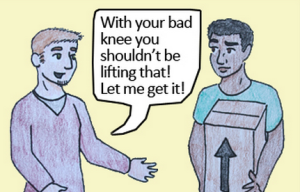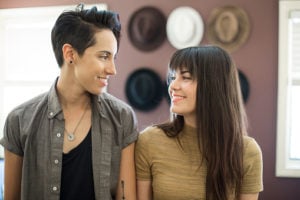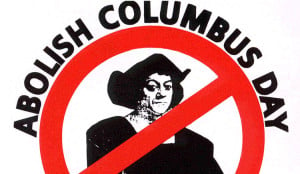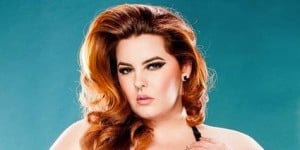
Source: Madame Noire
With books like The Hunger Games, Divergent, and The Fault In Our Stars and movies like Bridesmaids hitting the market in the last few years, women and girls are finally being represented – and not entirely negatively! – in media.
And while this is amazing, there are still groups of people who are largely underrepresented — including women and girls of color.
This lack of representation most certainly does a clear disservice to girls and women of color, but also to everyone.
Here are four reasons why.
1. Girls of Color Deserve to See Themselves in Young Adult Media
Growing up an avid reader of YA literature, I had numerous characters to look to and see myself represented — white, female, and middle-class.
Girls of color don’t have that luxury.
The only mainstream YA female characters of color from my youth that come to mind are Claudia Kishi (Asian) and Jessi Ramsey (Black) of the popular Baby-Sitters Club series.
In fact, a 2011 study done on protagonists featured on YA book covers showed that 90% were white, 1.4% were Latinx, 1.4% Asian, 1.2% Black, and 10% were of “ambiguous racial identity.”
90% were white.
It is long past time we gave girls of color fair playing time in books and movies.
Because including girls of color in YA media would not only benefit girls and young women; it would benefit society as a whole.
Boys and young men would be able to see girls and young women of color in roles other than the damsel in distress, the cute and sassy Black female sidekick, or the brilliant but doomed Asian villain, and they would understand that girls and women are much more than the sum of their appearances or their roles in relation to other men.
Similarly (although secondary in importance), the powers that be in media would see that placing girls of color in starring roles would appeal to a wider audience and create more profits for them!
Just look at the money that the aforementioned YA dystopias The Hunger Games and Divergent franchises brought in when Hollywood decided to (gasp!) allow women to play starring roles in movies.
The same could (and needs to!) happen for people – and especially women – of color, too.
2. Girls of Color Need Heroes, Too
As a little girl in the ‘60s, Whoopi Goldberg was reportedly watching Star Trek: The Original Series one day and noticed that a Black woman was playing Lieutenant Nyota Uhura (played by Nichelle Nichols), Chief Communications Officer of the USS Enterprise and one of the first Black characters on television to appear in a role that wasn’t that of maid, housekeeper, or slave.
(In addition, there were several other cast members of various races that were featured on the show, at a time when the majority of main characters on TV were white and male.)
After seeing this, Whoopi apparently ran into the next room and shouted, “There’s a Black lady on television, and she ain’t no maid!”
It was at this point, Whoopi says, that she realized that when she grew up, she could be anything that she wanted to be.
Children of color today deserve the opportunity to feel this way as well.
And although we’ve advanced somewhat since Stark Trek: TOS premiered and paved the way for multiculturalism and diversity in television, we still have a long way to go.
3. We Need to Do Away with the Narrative That POC Either Always Die in Movies or Are Cast As the Mystic, Charlatan, or Superstitious Wacko
Horror and action movies, both adult and young adult alike, are filled with the tired trope of people of color dying prematurely, with the ubiquitous white hero stepping in to save the day.
Popular horror movies like Alien, The Shining, and the Nightmare on Elm Street franchise all contain “token minority” characters that are killed by evil forces and left to die, only to later see this evil defeated by the white protagonist.
The Shining director Stanley Kubrick even took this stereotype a step further by altering the ending: In the book with the same title, Black character Dick Hallorann (Scatman Crothers) joins forces with child protagonist Danny to help defeat the evil spirits that reside inside the hotel. In other words, he is one of the book’s heroes.
So, with a quick white-centric rewrite, Kubrick makes Hallorann go from hero to victim (something that author Stephen King, to his credit, was not happy with).
Even timeless classics like Jurassic Park and Forrest Gump see Black characters dying off rather than becoming heroes, or at the very least, contributing more toward plot resolution than just getting killed.
And then there’s movies like the X-Men series that contain the “Expendable Asian Crewmember” trope, which has Asian characters cast as the evil villains as an excuse to be able to kill them off.
Another commonality with all of these movies that show people of color being killed? They rarely contain women of color.
So when Hollywood makes these types of films, they are sending the message to girls and women of color that 1) you’re rarely worthy enough to be cast as the token minority in one of our films, and 2) if you are “lucky” enough to be cast, you will not survive to the end of the movie.
These are not the kinds of messages that we want to be sending our girls and women of color. We need more heroes, not more victims.
In addition to killing off people of color, Hollywood also likes to cast the token minority mystic, charlatan, or superstitious side character.
In Paranormal Activity 2, for instance, the White family has a Latina maid (of course) who tries to banish the demonic force in the house by mumbling spells and burning incense until the family eventually fires her.
In Poltergeist II: The Other Side, a Native American “shaman” steps in to protect the Freeling family from the evil forces that surround it — an all-too-common incident of Native American stereotyping that I discussed in a previous article.
So don’t worry, people of color, says Hollywood — we may not have to kill you off; we’ll just cast you in the role of the crazy, pagan mystic! And this is unacceptable.
4. Media Needs to Represent Reality
In a world that’s growing less homogenized and more multiracial, it’s a fact that many of us will be members of more than one race in the near future.
And it’s important that what we read in books (or most likely, on e-readers) and watch on TV and computers reflects that reality.
Stereotypical roles based on strict divisions of race are ridiculous now, but they will be even more so by the year 2050.
It is likely that the female heroes of the future will not be the Anglo-Saxon Katniss Everdeens and Tris Priors, but rather their bi or multiracial equivalents (although it is important to note here that the movie version of Katniss is Anglo-Saxon, while the book version is described as being “olive,” which could indicate a person of color).
White people will no longer be the dominant majority, and movies should not portray them as such.
And as representatives of the lives we live, it is the media’s responsibility to acknowledge this and give the public what they deserve — equal representation.
***
Providing equal representation, portraying role models, eliminating stereotypical roles, and conveying reality are some of the ways in which the media can take steps toward being more inclusive of girls and women of color.
By doing this, we can move toward a more diverse and accurate variety of books, movies, and other media from which our young girls can choose.
What else should the media do to include more diversity? Share your thoughts in the comments below.
And for more on diversity in YA books and to get great recommendations, visit Diversity in YA.
[do_widget id=”text-101″]
Want to discuss this further? Visit our online forum and start a post!
Shannon Ridgway is a Contributing Writer to Everyday Feminism from the great flyover state of South Dakota (the one with the monument of presidential heads). In her free time, Shannon enjoys reading, writing, jamming out to ’80s music and Zumba, and she will go to great lengths to find the perfect enchilada. Follow her on Twitter@sridgway1980. Read her articles here.
Search our 3000+ articles!
Read our articles about:
Our online racial justice training
Used by hundreds of universities, non-profits, and businesses.
Click to learn more




















